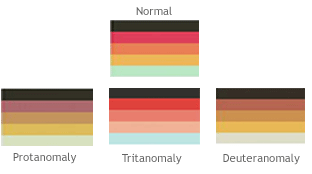What is Colorblindness?
The human eye sees by light stimulating the retina (a neuro-membrane lining the inside back of the eye). The retina is made up of what are called Rods and Cones. The rods, located in the peripheral retina, give us our night vision, but can not distinguish color. Cones, located in the center of the retina (called the macula), are not much good at night but do let us perceive color during daylight conditions.
The cones, each contain a light sensitive pigment which is sensitive over a range of wavelengths (each visible color is a different wavelength from approximately 400 to 700 nm). Genes contain the coding instructions for these pigments, and if the coding instructions are wrong, then the wrong pigments will be produced, and the cones will be sensitive to different wavelengths of light (resulting in a color deficiency). The colors that we see are completely dependent on the sensitivity ranges of those pigments.
Normal color vision which uses all three types of light cones correctly is known as trichromacy and people with normal color vision are known as trichromats and the condition is called Trichromacy.
There are many different types and degrees of colorblindness - more correctly called color vision deficiencies:
Anomalous Trichromacy

Anomalous Trichromacy is the most common category of color blindness. It is an impairment of normal color vision, not a complete loss. This occurs when one of the cones is altered in its spectral sensitivity. It can be red/green or blue/yellow depending on which cone is altered.The ability of anomalous trichromats to distinguish between hues is better than dichromats but still not normal.
There are 3 forms of Anomalous trichromacy :
Protanomaly: is a mild color vision defect in which an altered spectral sensitivity of red retinal receptors (closer to green receptor response ) results in poor red-green hue discrimination.
Deuteranomaly: caused by a similar shift in the green retinal receptors, is by far the most common type of color vision deficiency, mildly affecting red-green hue discrimination in 5% of males.
Tritanomaly: is a rare, hereditary color vision deficiency affecting blue-yellow hue discrimination unlike most other forms, it is not sex-linked
Dichromacy

It is a moderately severe color vision defect in which one of the three basic color mechanisms is absent or not functioning. It is hereditary. There are 3 forms of Drichromacy:
Protanomaly: is a severe type of color vision deficiency caused by the complete absence of red retinal photoreceptors. It is a form of dichromatism in which red appears dark.
Deuteranomaly: is a color vision deficiency in which the green retinal photoreceptors are absent, moderately affecting red-green discrimnation.
Tritanomaly: is a very rare color vision disturbance in which there are only two cone pigments present and a total absence of blue retinal receptors...
Monochromacy or (achromatopsia)

This form of complete color blindness is a very rare subtype of color vision deficiency among much more common ones like the the well known red-green color blindness. People suffering under monochromacy, perceive everything just in shades of gray.
Monochromacy, more commonly referred to as "total color blindness", is caused by the total absence of either 2 or 3 of the pigmented retinal cones, reducing vision to one dimension. Monochromacy comes in two forms:
Rod monochromacy: is a rare, non progressive inability to distinguish any color, resulting from non-functioning or absent retinal cones. Rod monochromacy is typically associated with sensitivity to light (Photophobia) and poor vision.
Cone monochromacy: is also a rare type of total color blindness, however is accompanied by relatively normal vision.
Information
Take a Test
Test your color vision online now with a test developed by a color vision specialist, Dr. Terrace L. Waggoner.
If you have any questions , please contact us at info@testingcolorvision.com.

